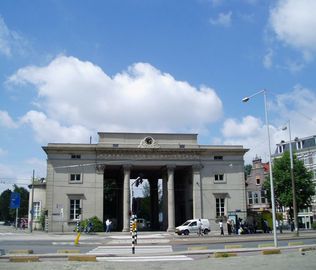

For centuries, the current Haarlemmerplein served as the waste dump for the western part of Amsterdam. When in the 17th century the city began to grow and became one of the largest commercial and industrial cities in Europe, the city walls were caused to expand. For example, in 1613 the city wall moved a mile westward! Between 1615 and 1618, on the site of the present Haarlemmerplein, a new Haarlemmerpoort (literally translated as the Haarlem Gate), designed by the renowned architect Hendrick de Keyser, was erected. The area around the gate was primarily used for commerce, transportation and all sorts of trades.
Whoever wanted to travel westward from Amsterdam had to use the Haarlemmerpoort and travel down the road running along the Spaarndammerdijk. It snaked endlessly along the IJ. This changed in 1631-1632 with the arrival of the Haarlemmertrekvaart that joined Amsterdam and Haarlem in an almost straight line. After that, once exiting Haarlemmerpoort, one could choose whether to travel down the old winding road along the Spaarndammerdijk, or take the new one built parallel to the canal. Needless to say, a heavy toll was levied for those who wanted to take the shortcut and travel along the new road. Moreover, carriages and wagons had no suspension at the time (the latter was only invented in the late 18th century), and it is therefore not surprising that the more comfortable gliding in a boat down the waterway was a popular means of transporting for leisurely travelers. By the middle of the 17th century, 150,000 people a year travelled by boat between the two cities. Those who owned country estates along the canal or further west in Kennemerland, always started off their journeys from the Haarlemmerpoort.
By the 1830s much had changed in and around the Haarlemmerplein. The city walls were demolished and in 1837, a year after the chimney had collapsed, the old gate was demolished. It was then replaced by the new gate that still stands in this place today, which is officially, in fact, called Willemspoort (Willem’s Gate), though everyone refers to it as Haarlemmerpoort.It is a rather imposing and oversized building for the function it used to fulfill: the collection of excise duties. The latter were abolished and, for a short time thereafter, the building served as a fire and a police station. It has survived various demolition plans since and currently it is a residential complex, inhabited by as many as 26 people.
In the 19th century another important historical event in the city took place, namely the construction of the first Dutch railway line. It ran from Amsterdam to Haarlem, practically parallel to the canal and the Haarlemmerweg, extending beyond the Haarlemerpoort.
In the 20th century the square teemed with garages and petrol filling stations. Nowadays, the only remaining garage is Kroon and S.W. Hettema (whose slogan reads “Through us everything runs as oiled”) and recognizable by the nostalgic ESSO sign. The business has been established since 1928 and those who ask politely may be allowed to take a look at the old city photographs hanging in the office.